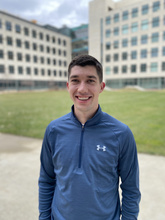
Hometown: Bettendorf, Iowa
Program: Doctor of Physical Therapy
What drew you to the field of physical therapy?
It’s a little cliché if you talk to a lot of physical therapy students, but when I was in high school, I injured myself and had to go through physical therapy myself. My physical therapist was my assistant cross-country coach, and while I was going through the process of being a patient, I was asking him all these questions and he became my mentor and gave me guidance.
Another factor that shaped my decision is all of the different experiences that Iowa has to offer. Getting into PT school at such a well-recognized program allowed me to experience a lot in the profession that kept drawing me in and reaffirming that this is what I want to do.
With Iowa being the No. 4-ranked doctoral PT program in the country, what are some of the program’s biggest strengths?
One of the things that really drives our program to be successful is that we have a lot of leaders on our staff and a lot of students that are driven to become leaders. A lot of our staff does research that is nationally recognized in a multitude of areas, which is a huge strength—not only from a research standpoint but driving the profession forward from a student perspective of graduating great clinicians and great leaders.
Another great aspect of the program is how hard our leadership pushes us students in terms of being both academically driven but also being a well-rounded student and community service leader in the clinic and in the community.
You did some of your clinical experience at a hospital in Springfield, Missouri during the second wave of COVID. What did you learn from that experience?
It was an interesting experience that I wasn’t necessarily expecting; I was expecting to see a more typical caseload seen during a common hospital rotation. It was the COVID hotspot during the summer, with low vaccination rates in that part of Missouri, and I was working in the ICU and emergency room. I was only there for nine weeks, but I was working with nurses, respiratory therapists, and physical therapists in intensive care, and that was their day-in and day-out. It was difficult for me to see the stress put on them. There were patients in the ICU that would be there one day, and the next they were gone. I didn’t know whether they moved to a different part of the hospital or if they didn’t make it.
It’s a fast-moving environment of having to stay on your feet and stay quick with what the nurses were telling you. It was a great experience from that standpoint, but it was difficult emotionally to see.
Can you share a memorable story about your time in Springfield?
We worked with ECMO [extracorporeal membrane oxygenation] patients, which is the most advanced life support you can be on, and we had a patient who was in a coma that had just come off ECMO. His family wanted to exhaust all options, and he eventually came out of the coma and was able to move on. After weeks of being bedridden, the first time he sat up on the edge of his bed, the respiratory therapists got super emotional because they just needed a win. They just needed one thing to keep them going. It wasn’t an ideal situation for the staff, but I really do commend everyone there, from the intensivists to the nursing staff and all the way to people who help to clean rooms, because it really was a team effort. It wasn’t easy for me. And I know it’s harder for them being there day to day.
What has been your motivation to push forward in your education, after plenty of pandemic-related obstacles?
Our program is frontloaded with didactic work while we save our 9-week long clinical rotations for the end of the curriculum. In March 2020, when the pandemic hit, we went fully online, and it was hard to do online classes. The motivation came from us students encouraging each other and keeping up with each other with constant communication, even from our apartments.
From a clinical standpoint, my patients have been the motivating factor for me. Seeing patients go through their situation and come out better on the other side is what inspires me to be my best. The motivating factor was seeing those patients take advantage of their time with me and what they can do to improve their own function.
What are your plans after graduating?
As a class, we take boards in late January. Shortly after that, I’ll be moving down to Kansas City to begin working in a private practice and an outpatient orthopedic clinic. I had one of my clinical rotations down there in an outpatient rehab clinic where I worked with spinal cord patients and patients with amputations. It was a short clinical, but it gave me enough time to scout out the area.
Do you have any advice for aspiring PT students?
It’s a very rewarding profession but give it a lot of thought and research before you go into it because it is a lot of schooling. There’s a lot of things changing in the field right now, and COVID has accelerated that. Make sure to get as much experience with clinical rotations and see a wide variety of physical therapy settings. When I first started, I never knew that physical therapists worked in the emergency department or the ICU. I thought it was just what my rotation looks like right now, working in a stand-alone clinic.
Also, enjoy the process. I did my undergrad and graduate school at Iowa, so that’s six and a half years. Looking back, I will remember all the memories and all the fun experiences I had throughout the process. The degree will come—don’t forget to be present in the moment.